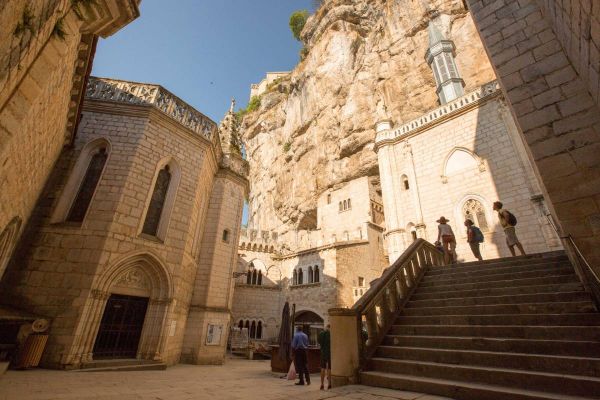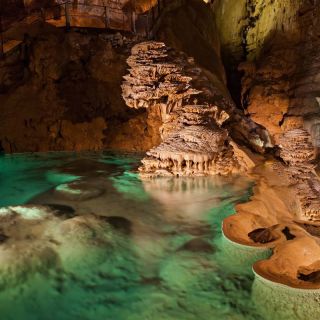
Rocamadour, sanctuary on the edge of the rock
Located on the road to Saint-Jacques-de-Compostelle, the medieval and religious city of Rocamadour hangs on the side of a cliff 120 m above the Alzou canyon: a true miracle! Its proximity to Brive (less than an hour's drive) makes it one of the great sites to visit.
In the Lot region, a few kilometers from Gramat, Rocamadour is one of the most visited historical and religious sites in France. Every year, nearly a million curious people come to discover the village but also, and above all, the sanctuary with its seven chapels, including the Saint-Sauveur basilica, the Saint-Amadour crypt, listed as a UNESCO World Heritage Site, and the Notre-Dame chapel, built in the hollow of the rock and which shelters the Black Virgin of Rocamadour. But such a treasure has to be earned: you have to climb a staircase of more than 200 steps to access it. So, are you ready for a spiritual ascent in Rocamadour?
5 good reasons to go to Rocamadour
- Admire the breathtaking panorama offered over the Alzou canyon from the ramparts of the Castle, then descend towards the sanctuary via the Stations of the Cross.
- Visit the Black Virgin of Rocamadour in the Notre-Dame chapel and see the miraculous bell.
- Discover Durandal, the sword of the knight Roland, planted in the cliff.
- Walk the unique street of Rocamadour, see its fortified gates and enjoy its shops.
- Taste and enjoy some rocamadour, a small goat cheese, cousin of cabécou.
The sanctuary of Rocamadour
The history of the sanctuary
When did the origins of Rocamadour date back? Hard to say. In any case, it is certain that men already occupied the place in prehistoric times, as evidenced by the numerous paintings found on the walls of the local caves.
Legend has it that a hermit named Saint Amadour settled on the site around the XNUMXth century and dug a first chapel into the rock.
From the year 12, the place was dedicated to the worship of the Virgin Mary and the first pilgrimages began. In the XNUMXth century, Rocamadour was even one of the main holy places of Christianity along with Jerusalem, Rome and Santiago de Compostela. And it was at this same time that began, at the request of the Abbot of Saint-Martin, the construction of the sanctuary consisting of the Saint-Sauveur basilica which surmounts the crypt containing the remains of Saint Amadour, but also of the various chapels and churches on the site.
In the 13th century, a defense building called “the Castle” was built on the plateau overlooking the sanctuary to ensure its protection. Later, in the 19th century, a station of the cross was built and connected the heights of the sanctuary to the center of the city of Rocamadour.
The Black Virgin of Rocamadour
Contrary to what Gérard Blanchard's song says, there are no wolves in Rocamadour. On the other hand, there is indeed a love or rather an intense devotion for the Virgin Mary. It is to her that pilgrims have come to pray every year for centuries in the heart of the Notre-Dame-de-Rocamadour chapel. Inside, they gather in front of the famous Black Madonna of Rocamadour, a 12th century statue in walnut wood representing Mary holding her son Jesus in her arms.

Notre-Dame-de-Rocamadour is said to have performed numerous miracles over the centuries. She is particularly considered the protector of sailors because she is said to have repeatedly saved men from peril at sea by ringing the so-called “miraculous” bell, suspended from one of the vaults of her chapel.
Rocamadour and Durandal, the sword of Roland
In Rocamadour, a part of mystery reigns thanks to the numerous miracles and legends which surround the place. There is one more significant than the others and it is linked to the knight Roland, from the famous medieval poem The Song of Roland. During the battle of Roncesvalles against the Saracens, the brave knight was seriously injured. Not wanting the enemy to steal his sword, the aptly named Durandal, he attempts to break it against a rock. But it's wasted effort: the object resists. He asks for help from the archangel Saint Michael who transports the legendary sword to Rocamadour and plants it in the cliff. Today, it still stands proudly hanging on the rock, near the Notre-Dame chapel.
What else to do in Rocamadour?
Discover the village of Rocamadour
The city of Rocamadour is, of course, known for its religious sanctuary but it's not the only thing to see there. Starting with the village of Rocamadour which has the particularity of being built around a single street, rue de la Couronnerie. Throughout its route, you will be able to admire numerous fortified gates which, in the past, protected access to the sanctuary. Obviously, you can't leave Rocamadour without tasting (and bringing back!) the little goat's cheese that bears its name. You will inevitably find what you are looking for in one of the many shops that line rue de la Couronnerie.

Hiking in Rocamadour
If the 200 or so steps leading to the sanctuary haven't got the better of you, you won't mind a little hike around Rocamadour? On foot, it is possible to follow five routes of various lengths and difficulties:
- The stone and water circuit, a 5,9 km circuit;
- The 3 caves loop, an 8,6 km circuit;
- Between Ouysse and Alzou, an 8,9 km circuit;
- The Alzou canyon, a 14,3 km circuit;
- The path to Rocamadour and the 2 valleys, a 16,1 km circuit.
It is also possible to cycle along the “Betwee Ouysse and Causse” route, which is 25,5 km long.
The not-to-be-missed events of Rocamadour
The week and the Marian feasts
If pilgrims flock to Rocamadour all year round, their number intensifies at the beginning of September with the celebration of the birth of the Virgin Mary on September 8. On the agenda for Marian week: masses, processions and services to honor the one who watches over the sanctuary. And every month, feasts are also organized in her honor around various activities.
The Montgolfiades of Rocamadour
The fourth weekend of September, the Montgolfiades take off from Rocamadour. A unique event in Europe with two days punctuated by the takeoff of numerous hot air balloons. Enough to gain height and discover the Alzou canyon in a different way.
The Brive-Rocamadour hike
The legendary Brive-Rocamadour is a mountain bike and hiking trail which takes place every year in March. It's the most beautiful way to leave your mark on the slopes and paths that connect Brive to Rocamadour.
Pratical information
Where is Rocamadour?
Rocamadour is located 10 km from Gramat, approximately 50 km from Brive and Sarlat. It takes about an hour by car from Brive.
To visit and hike in Rocamadour
The Dordogne Valley tourist office team welcomes you to their office located in L'Hospitalet in Rocamadour. Otherwise, give them a call at +05 65 33 22 00 XNUMX.
Everything you need to know about Rocamadour
To organize your visit to Rocamadour without worrying, we have prepared a practical guide for you to find here.

Our tip Enjoy Rocamadour out of season

You can't pass by the area and not go to Rocamadour. This village hanging from the mountain, wedged between sky and earth, is a place of pilgrimage where Durandal, the sword of Roland, was supposedly transported by the archangel Saint Michael. And, very close by, there is the most famous chasm in France: the Gouffre de Padirac. Go for a boat trip, you'll find yourself straight at Jules Verne's house... All that in closely bunched together: the trip is truly extraordinary.
Medieval village of Rocamadour,
46500 Rocamadour
05 55 24 08 80 (Brive Agglomération tourist office)
Share this article
Or share the link
You will also like...




